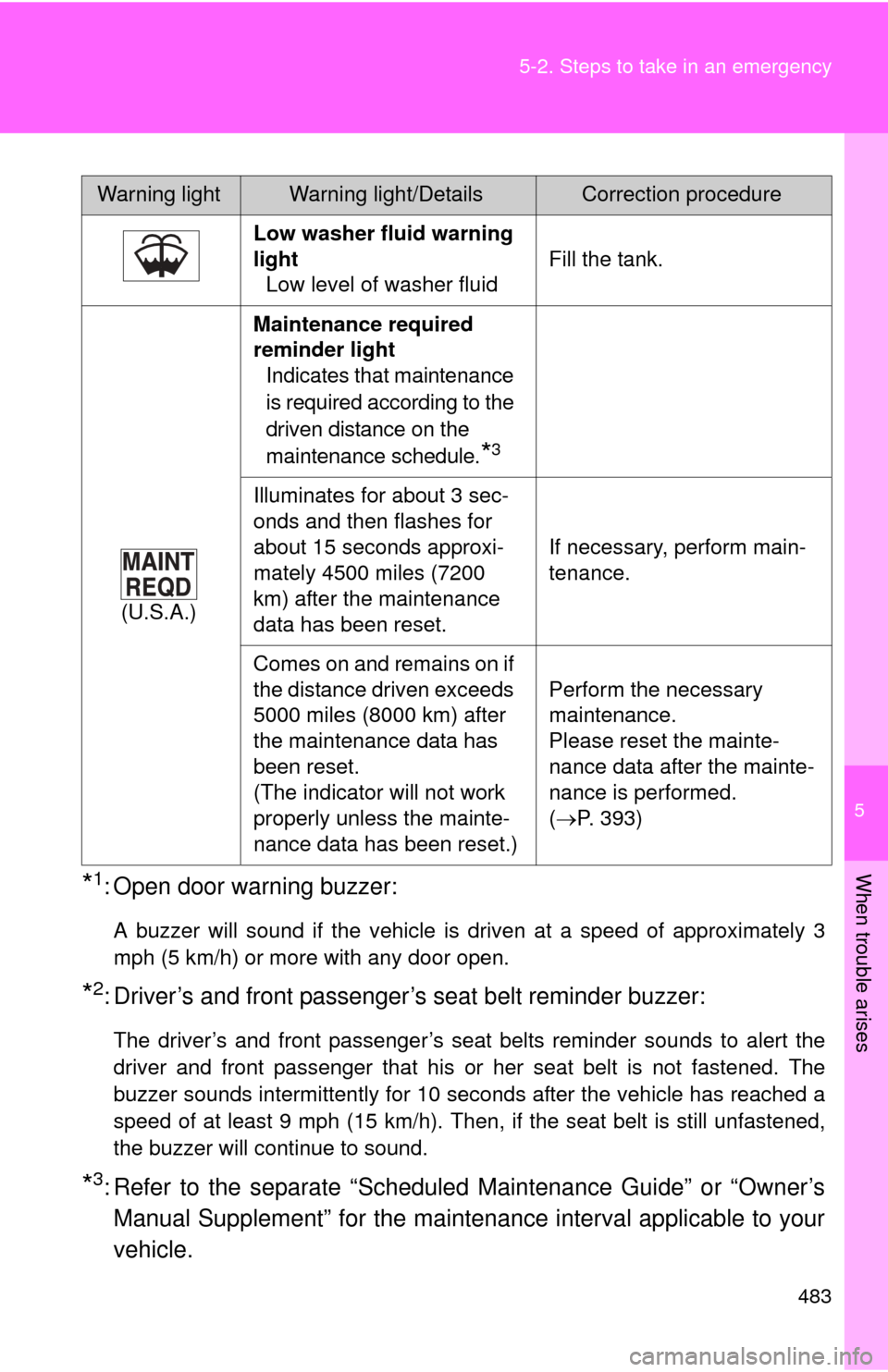Page 468 of 580

468 4-3. Do-it-yourself maintenance
■Bulbs other than the above
If any of the bulbs listed below has burnt out, have your Toyota
dealer replace it.
● Headlights (discharge bulb)
● Side turn signal lights
● Tail lights
● High mounted stoplight
■Condensation build-up on th e inside of the lens
Contact your Toyota dealer for more information in the following situations.
Temporary condensation build-up on the inside of the headlight lens does
not indicate a malfunction.
● Large drops of water are built up on the inside of the lens.
● Water has built up inside the headlight.
■ LED light bulbs
The side turn signal lights, tail lights and high mounted stoplights consist of a
number of LEDs. If any of the LEDs burn out, take your vehicle to your
Toyota dealer to have the light replaced.
If two or more LEDs in a stoplight bur n out, your vehicle may not conform to
local laws (SAE).
■ High-intensity discharge (HID) headlights (if equipped)
If voltage to the high-intensity discharge bulbs is insufficient, the light may
not come on, or may go out temporarily. The high-intensity discharge bulbs
will come on when normal power is restored.
Page 469 of 580
4
Maintenance and care
469
4-3. Do-it-yourself maintenance
CAUTION
■
Replacing light bulbs
●Turn off the headlights. Do not attempt to replace the bulb immediately
after turning off the headlights.
The bulbs become very hot and may cause burns.
● Do not touch the glass portion of the light bulb with bare hands. Hold the
bulb by the plastic or metal portion.
If the bulb is scratched or dropped it may blow out or crack.
● Fully install light bulbs and any parts used to secure them. Failing to do so
may result in heat damage, fire, or water entering the headlight unit. This
may damage the headlights or cause condensation to build up on the lens.
● Do not take apart or repair the low beam discharge headlight bulbs, con-
nectors, power supply circuits, or related components.
Doing so could result in electric shock and death or serious injury.
Page 470 of 580
470 4-3. Do-it-yourself maintenance
CAUTION
■High-intensity discharge (HID) headlights (if equipped)
●Contact your Toyota dealer before replacing high-intensity discharge
headlights (including light bulbs).
● Do not touch the high-intensity discharge headlight’s high voltage socket
when the headlights are turned on. An extremely high voltage of 20000V
will be discharged and could result in serious injury or death by electric
shock.
■ To prevent damage or fire
Make sure bulbs are fully seated and locked.
●Low beam metal back cover may be
very hot after operation of engine and/
or low beams. To avoid potential burn,
do not touch metal back cover under
these conditions.
When replacing the high beam lights
and parking lights, take care as you will
probably touch the low beam metal
back cover.
Page 483 of 580

5
When trouble arises
483
5-2. Steps to take in an emergency
*1: Open door warning buzzer:
A buzzer will sound if the vehicle is driven at a speed of approximately 3
mph (5 km/h) or more with any door open.
*2: Driver’s and front passenger’s seat belt reminder buzzer:
The driver’s and front passenger’s seat belts reminder sounds to alert the
driver and front passenger that his or her seat belt is not fastened. The
buzzer sounds intermittently for 10 seconds after the vehicle has reached a
speed of at least 9 mph (15 km/h). Then, if the seat belt is still unfastened,
the buzzer will continue to sound.
*3: Refer to the separate “Scheduled Maintenance Guide” or “Owner’s
Manual Supplement” for the maintenance interval applicable to your
vehicle.
Warning lightWarning light/DetailsCorrection procedure
Low washer fluid warning
light Low level of washer fluid Fill the tank.
(U.S.A.)
Maintenance required
reminder light Indicates that maintenance
is required according to the
driven distance on the
maintenance schedule.
*3
Illuminates for about 3 sec-
onds and then flashes for
about 15 seconds approxi-
mately 4500 miles (7200
km) after the maintenance
data has been reset. If necessary, perform main-
tenance.
Comes on and remains on if
the distance driven exceeds
5000 miles (8000 km) after
the maintenance data has
been reset.
(The indicator will not work
properly unless the mainte-
nance data has been reset.) Perform the necessary
maintenance.
Please reset the mainte-
nance data after the mainte-
nance is performed.
(
P. 393)
Page 489 of 580

5
When trouble arises
489
5-2. Steps to take in an emergency
CAUTION
■If the tire pressure warning light comes on
Be sure to observe the following precautions. Failure to do so could
cause loss of vehicle control and result in death or serious injury.
●Stop your vehicle in a safe place as
soon as possible. Adjust the tire
inflation pressure immediately.
●If the tire pressure warning light comes on even after tire inflation pres-
sure adjustment, it is pr obable that you have a flat tire. Check the tires.
If the tire is flat, change to the spare tire and have the flat tire repaired
by the nearest Toyota dealer.
●Avoid abrupt maneuvering and braking. If the vehicle tires deteriorate,
you could lose control of the steering wheel or the brakes.
■If a blowout or sudden air leakage should occur
The tire pressure warning syste m may not activate immediately.
■Maintenance of the tires
Each tire, including the spare (if provided), should be checked monthly
when cold and inflated to the inflation pressure recommended by the
vehicle manufacturer on the vehicle placard or tire inflation pressure
label (tire and load information label). (If your vehicle has tires of a differ-
ent size than the size indicated on the vehicle placard or tire inflation
pressure label [tire and load information label], you should determine the
proper tire inflation pr essure for those tires.)
As an added safety feature, your vehicle has been equipped with a tire
pressure monitoring system (TPMS-ti re pressure warning system) that
illuminates a low tire pressure telltal e (tire pressure warning light) when
one or more of your tires is significantly under-inflated. Accordingly,
when the low tire pressure telltale (tire pre ssure warning light) illumi-
nates, you should stop and check your tires as soon as possible, and
inflate them to the proper pressure. Driving on a significantly under-
inflated tire causes the tire to overheat and can lead to tire failure.
Under-inflation also reduces fuel effi ciency and tire tread life, and may
affect the vehicle’s handling and stopping ability.
Page 490 of 580

490 5-2. Steps to take in an emergency
CAUTION
Please note that the TPMS (tire pressure warning system) is not a sub-
stitute for proper tire maintenance, and it is the driver’s responsibility to
maintain correct tire pressure, even if under-inflation has not reached the
level to trigger illu mination of the TPMS low tire pressure telltale (tire
pressure warning light).
Your vehicle has also been equipped with a TPMS (tire pressure warning
system) malfunction indicator to indi cate when the system is not operat-
ing properly. The TPMS (tire pressure warning system) malfunction indi-
cator is combined with the low tire pressure telltale (tire pressure
warning light). When the system det ects a malfunction, the telltale will
flash for approximately one minute an d then remain continuously illumi-
nated. This sequence will continue upon subsequent vehicle start-ups as
long as the malfunction exists. When the malfunction indi cator is illumi-
nated, the system may not be able to detect or signal low tire pressure
as intended.
TPMS (tire pressure warning system) malfunctions may occur for a vari-
ety of reasons, including the installati on of replacement or alternate tires
or wheels on the vehicle that prevent the TPMS (tire pressure warning
system) from functioning properly. Always check the TPMS (tire pres-
sure warning system) malfunction te lltale after replacing one or more
tires or wheels on your vehicle to ensure that the replacement or alter-
nate tires and wheels allow the TPMS (tire pressure warning system) to
continue to function properly.
NOTICE
■Precaution when installing a different tire
When a tire of a different specification or maker is installed, the tire pres-
sure warning system may not operate properly.
Page 519 of 580
Vehicle specifications6
519
6-1. SpecificationsMaintenance data (fuel, oil level, etc.) ......... 520
Fuel information ............... 528
Tire information ................ 532
6-2. Customization Customizable features ..... 545
6-3. Initialization Items to initialize .............. 549
Page 520 of 580
520
6-1. Specifications
Maintenance data (fuel, oil level, etc.)
Dimensions and weight
*: Unladen vehicle
Overall length197.6 in. (5020 mm)
Overall width72.8 in. (1850 mm)
Overall height*58.5 in. (1485 mm)
Wheelbase111.0 in. (2820 mm)
TreadFront62.2 in. (1580 mm)
Rear61.6 in. (1565 mm)
Vehicle capacity weight
(occupants + luggage) 870 lb. (395 kg)